BEIJING, Beijing, April 11 (Reporter Song Yuxi Ying Ni) On the 10th, after a one-and-a-half-day presentation, the "Top Ten New Archaeological Discoveries in China in 2017" was announced in Beijing.
The reporter learned from the press conference that Xinjiang Jimunai Tongtiandong Site, Shandong Zhangqiu Jiaojia Site, Shaanxi Gaoling Yangguanzhai Site, Ningxia Pengyang Yaoheyuan Western Zhou Site, Henan Xinzheng Zhenghan Ancient City Site, Shaanxi Xi ‘an Qin and Han Quercus City Site, Henan Luoyang Eastern Han Mausoleum Archaeological Investigation and Excavation, Jiangxi Yingtan Longhushan Dashangqing Palace Site, Jilin Antu BMW City Jin Dynasty Changbai Mountain Temple Site, Sichuan Pengshan Jiangkou Shenyin Site were selected as "2017"
Why are these new archaeological discoveries selected? The reporters sorted them out one by one.
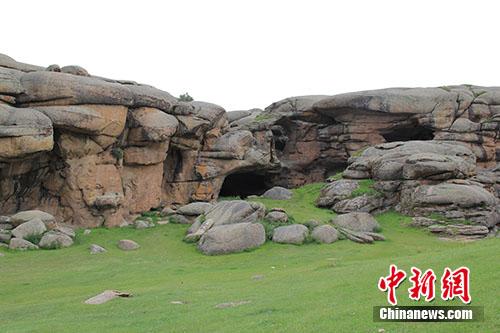
Xinjiang Jimunai Tongtian Cave Site
Tongtian Cave Site is located in a granite cave in the northeast of Kuotasi Village, Thost Township, Jimunai County, Altay Prefecture, Xinjiang Uygur Autonomous Region. It is located in Altay Prefecture, Xinjiang, and is the main road leading to Central Asia and Europe in the northwest of China.
As the first Paleolithic cave site found in Xinjiang, it completely preserves the remains of ancient human life and residence from the Paleolithic to 3,500 years ago.
Paleolithic tools were found in the site — Copper and stone are used together — Bronze — The continuous stratigraphic section of the Early Iron Age not only fills the blank of prehistoric cave archaeology in Xinjiang, but also is a major discovery of paleolithic archaeology in China, which is of great significance for understanding the evolution and development process of ancient humans in Xinjiang for more than 40,000 years and establishing the chronological framework of regional cultural development. In addition, earlier wheat in China was found in the site.
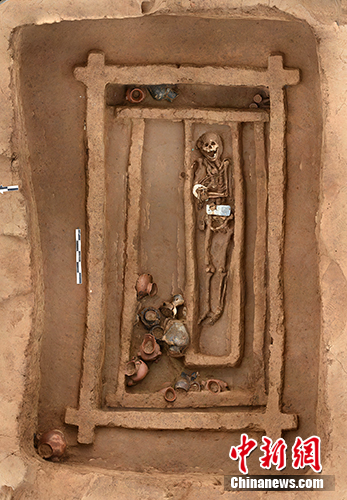
Jiaojia Site in Zhangqiu, Shandong Province
Jiaojia Site in Zhangqiu District, Jinan is located in the piedmont plain on the north side of Taiyi Mountain System, and its main era is the middle and late stage of Dawenkou culture. Abundant cultural remains of Dawenkou were found in the excavation.
In the ruins, the orderly arrangement of housing materials in space fills the gap in the study of living form in the middle and late stage of Dawenkou culture in central and northern Shandong Province. At the same time, the excavated tomb materials are extremely rich, and the funerary objects are common jade cymbals, jade bracelets, pottery cups with high handles, white pottery and painted pottery.
It is worth mentioning that it has been reported before that archaeologists found that the tallest male owner of the tomb actually reached 1.9 meters in length by measuring human bones, and many of them exceeded 1.8 meters.
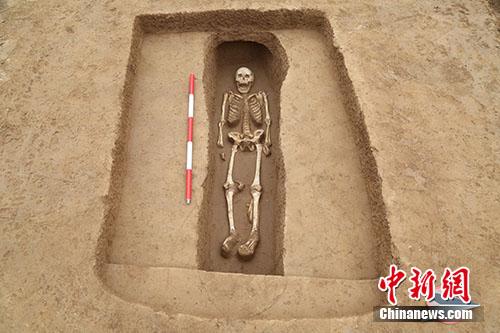
Yangguanzhai Site in Gaoling, Shaanxi Province
Yangguanzhai Site is located in the east of Group 4 of Yangguanzhai Village, Jijia Street, Gaoling District, Xi ‘an City, Shaanxi Province, and is a central settlement in the middle and late Yangshao period in Guanzhong area.
In 2015-2017, Shaanxi Institute of Archaeology discovered a large public cemetery when it carried out targeted archaeological excavations in the northeast of the site. After preliminary investigation, the total area of the cemetery is over 85,000 square meters. At present, the excavated area is about 3,800 square meters, and 343 prehistoric tombs have been discovered.
Archaeological results show that the tombs are all buried by one person at a time, and the human bones are intact, with abnormal death and human bone displacement. Earlier, it was also reported that among the excavated tomb sites, there were tomb owners who "appeared to have been ‘ Chop hands ’ The strange phenomenon. "
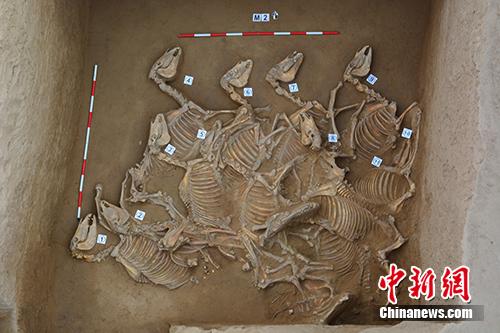
Western Zhou ruins of Yaoheyuan, Pengyang, Ningxia
Yaoheyuan Site is located in Xinji Township, Pengyang County, Ningxia, and it is a large Western Zhou Dynasty site first discovered in the upper reaches of Jingshui River in southern Ningxia.
Water networks, road networks, trenches, walls and ash pits are found in the residential area. The burial area is located in the northeast of the site, and more than 50 tombs, horse pits, chariot pits and sacrificial pits have been drilled.
The discovery of these important relics shows that the Yaoheyuan site has an unusual rank and status, and belongs to a Duyi site that was sealed off by the Western Zhou Dynasty. The site of Yaoheyuan provides valuable new information for understanding the political structure of the Western Zhou Dynasty and the relationship between the Zhou Dynasty and the northwest border areas.
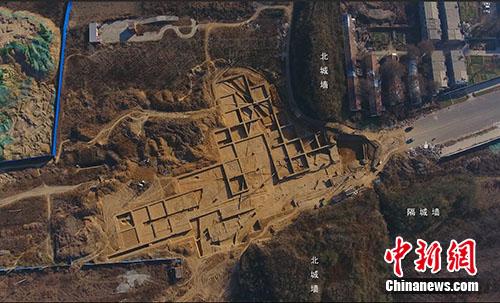
Henan Xinzheng Zhenghan Ancient City Ruins
The site of Beichengmen, the ancient city of Zheng and Han, is the first scientific excavation of the city gate of Zheng and Han in history. It not only fully reveals the structure of the city gate during the Spring and Autumn Period and the Warring States Period, but also confirms the record of "Qumen" in the history books, which plays a role in proving history and school history. At the same time, the wall of the urn city with a defense system during the Warring States period was also discovered, which was also discovered for the first time in the ruins of the king city in the Eastern Zhou Dynasty in the Central Plains.
The No.3 chariot pit in Zheng State is another great discovery after the tomb of Zheng Gong. There are 4 wooden carts left in the pit, and in addition to the previous excavation, there are 48 buried carts and more than 124 horses in Zhenggong Tomb, and many vehicles and horses have been unearthed, which is rare in archaeological discoveries in the Eastern Zhou Dynasty.
It is worth mentioning that the colorful mat ceiling decorated with bronze and bone artifacts and the large-scale car with a length of about 2.2 meters provide an important academic basis for studying the burial system and customs of horses and chariots in the Zhou Dynasty in China.
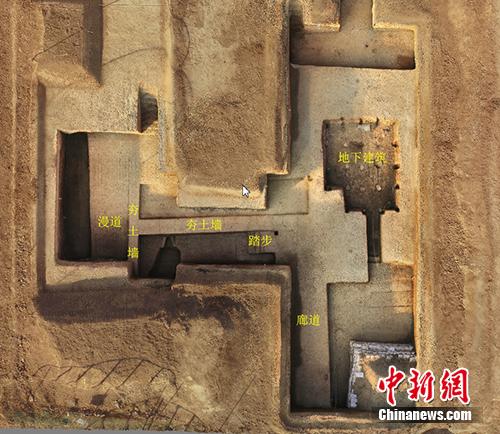
Ruins of Liyang City in Qin and Han Dynasties in Xi ‘an, Shaanxi Province
The site of Liyangcheng is located in yanliang district, Xi ‘an City, Shaanxi Province. In 2013, Epang Palace and Shanglinyuan Archaeological Team restarted the archaeological work of Liyang in order to further determine the protection scope of the site and provide information for the protection planning.
This archaeological survey revisited the south wall, the west wall and the north wall (numbered "No.1 Ancient City") of the archaeological exploration site in 1980-1981, and identified "No.2 Ancient City" and "No.3 Ancient City" through exploration and excavation, and identified a number of large palace buildings in No.3 Ancient City.
According to the documents and unearthed relics, the upper limit of No.3 ancient city was not earlier than the mid-Warring States period, which coincided with the time when Qin Xiangong and Xiaogong built the capital, namely, Liyang, Qin Dou, in the Warring States period, where Shang Yang’s political reform took place.
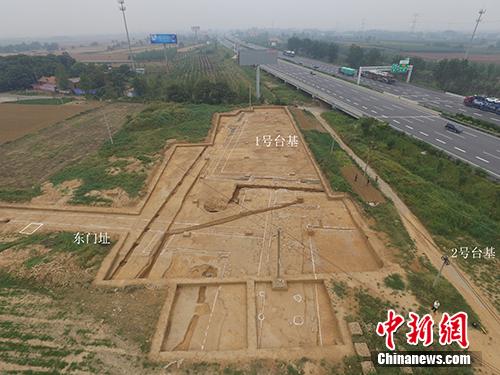
In the archaeological investigation and excavation project of the Eastern Han Dynasty Mausoleum in Luoyang, Henan Province, the east of No.1 abutment of Zhucang M722 Mausoleum Site and the east gate of Inner Mausoleum are located. Photo courtesy
Archaeological Investigation and Excavation of the Eastern Han Mausoleum in Luoyang, Henan Province
Luoyang Institute of Cultural Relics and Archaeology, combined with the project "Archaeological Investigation and Survey of Mangshan Mausoleums", conducted a large-scale investigation and exploration of the Eastern Han Mausoleum and its cemetery sites, with a total exploration area of 2.56 million square meters. Through more than ten years of archaeological work, the basic characteristics of the tombs of the Eastern Han emperors have been clarified.
The enclosure plane of the Eastern Han Mausoleum is circular, and the tomb is a "A"-shaped tomb with a long slope, and the tomb is facing south. The layout of the Eastern Han Dynasty cemetery sites has gradually become clear. The Eastern Han cemetery adopted the internal and external cemetery system. Inner cemetery is centered on the buried tomb of Empress Dowager, surrounded by surrounding walls or roads. The outer cemetery is mainly based on a large area of rammed earth buildings, which are concentrated in the northeast side of the inner cemetery.
This series of investigations and excavations provide important reference materials for studying the connotation and evolution of the mausoleum system in the Eastern Han Dynasty and further discussing the ownership of the tombs, which provides important support for the protection of the Eastern Han Mausoleum in Luoyang in the future.
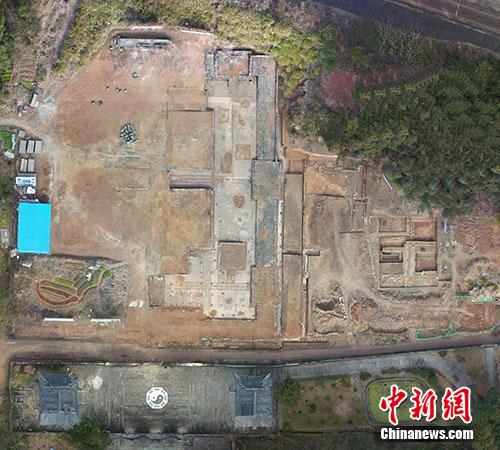
Site of Dashangqing Palace in Longhushan, Yingtan, Jiangxi Province
Dashangqing Palace Site is located in the east of Shangqing Town, Longhu Mountain, Yingtan City, Jiangxi Province. It was discovered in June 2014, and then Jiangxi Provincial Institute of Cultural Relics and Archaeology carried out archaeological excavation for nearly four years.
At present, it has been revealed that the core area of the Great Shangqing Palace is 5,000 square meters east of the central axis of the Palace. The building bases are Longhumen, Yuhuang Hall, Houtu Hall, Sanqing Pavilion, Sanguan Hall, Wuyue Hall, Emperor Hall, Wenchang Hall, Ming and Qing Dynasties Monument Pavilion, East Wing Room, etc., surrounded by brick courtyard walls.
Through the mutual textual research with the literature records, it is inferred that the building age of the main temple base site is Ming Dynasty. A large number of building materials from Song Dynasty to Qing Dynasty, such as tiles, dripping water, ridged beasts, stone railings, and household utensils, such as money and ceramics, were unearthed from the site of Dashangqing Palace, which provided valuable materials for exploring the historical evolution and construction art of Dashangqing Palace, and also provided valuable first-hand materials for studying the development history of Taoism and Taoist archaeology.
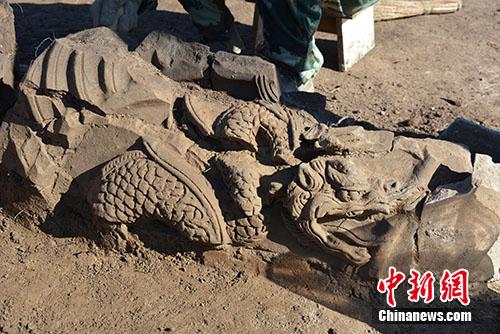
Ruins of Changbai Mountain Temple in Jin Dynasty in BMW City, Antu, Jilin
The site of Baomacheng is located in Baihe Town, Erdao, Antu County, Jilin Province. In the past, academic circles thought that the site was built in Bohai Sea and was used by Liao and Jin Dynasties. Jilin Provincial Institute of Cultural Relics and Archaeology and Frontier Archaeology Research Center of Jilin University conducted continuous exploration and excavation from 2014 to 2017, and basically grasped the layout of the building group, the shape and function of the main single buildings in BMW City, and also got a preliminary understanding of the direction of the drainage system inside and outside the city. More than 5,000 pieces of various relics were unearthed, among which the "Guichou" (1193) jade album unearthed in 2016 confirmed that it was the Changbai Mountain Temple built by the Jin Dynasty royal family.
The site of Baomacheng is an important archaeological discovery in Liao and Jin Dynasties in recent years, which provides valuable information for the study of material culture and official architecture in Jin Dynasty. The excavation of this site is the first discovery of the remains of the national mountain sacrifice outside the Central Plains, which is of great value to understanding the pattern of the temple of Duci in Yuehai Town during the Song and Jin Dynasties and exploring the development of the etiquette system in the Jin Dynasty. It is also of great significance to studying the border strategy of the Jin Dynasty and exploring the formation and development of a unified multi-ethnic country in China, and will also have a positive and far-reaching impact on enriching the connotation of Changbai Mountain’s long history and culture.
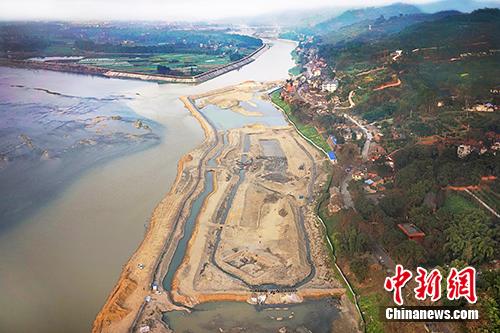
Shenyin Ruins in Pengshan Jiangkou, Sichuan
Jiangkou Shenyin Site is located in the Minjiang River in Jiangkou Town, Pengshan District, Meishan City, Sichuan Province, about 60 kilometers south of Chengdu, with an area of about 1 million square meters.
From January to April, 2017, Sichuan Institute of Cultural Relics and Archaeology, together with National Cultural Heritage Administration Underwater Cultural Heritage Protection Center and Pengshan District Cultural Relics Protection Management Office of Meishan City, carried out the first archaeological excavation of the Shenyin site in Jiangkou, with a total of more than 30,000 pieces of various cultural relics, which proved the legend of Shenyin in in Jiangkou, Zhang Xianzhong, and made a major breakthrough.
The unearthed cultural relics include the gold seal book belonging to the Daxi regime in Zhang Xianzhong, gold coins, silver coins and copper coins of Dashun Tongbao, and silver ingots engraved with the name and year of Daxi. From the time point of view, it lasted from the middle of Ming Dynasty to the late Ming Dynasty. Geographically, these cultural relics came from Henan in the north, Guangdong and Guangxi in the south, Sichuan in the west and Jiangxi in the east, covering more than half of China in the Ming Dynasty.
The excavation of the Shenyin site in Jiangkou and the emergence of a large number of precious cultural relics are of great significance to the study of the political system, social economy, material culture and even the social and historical trend in the late Ming and early Qing dynasties. (End)
关于作者